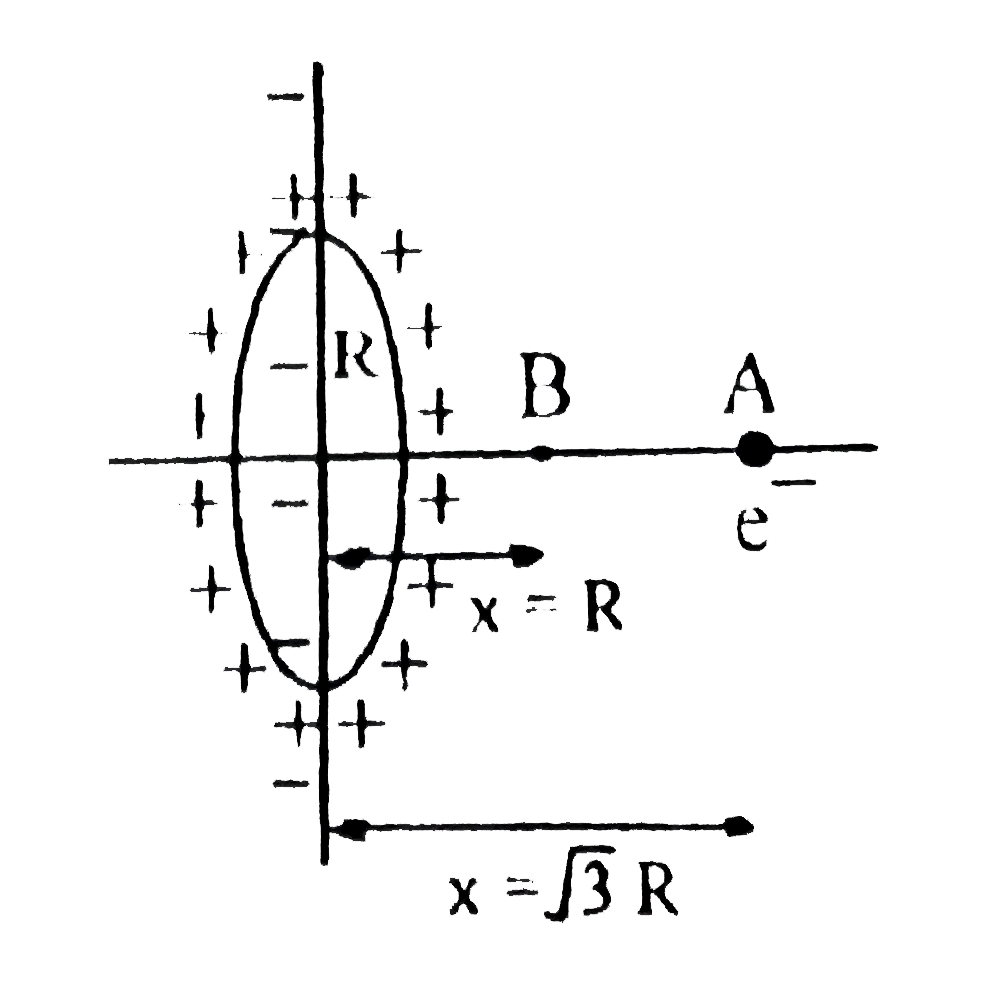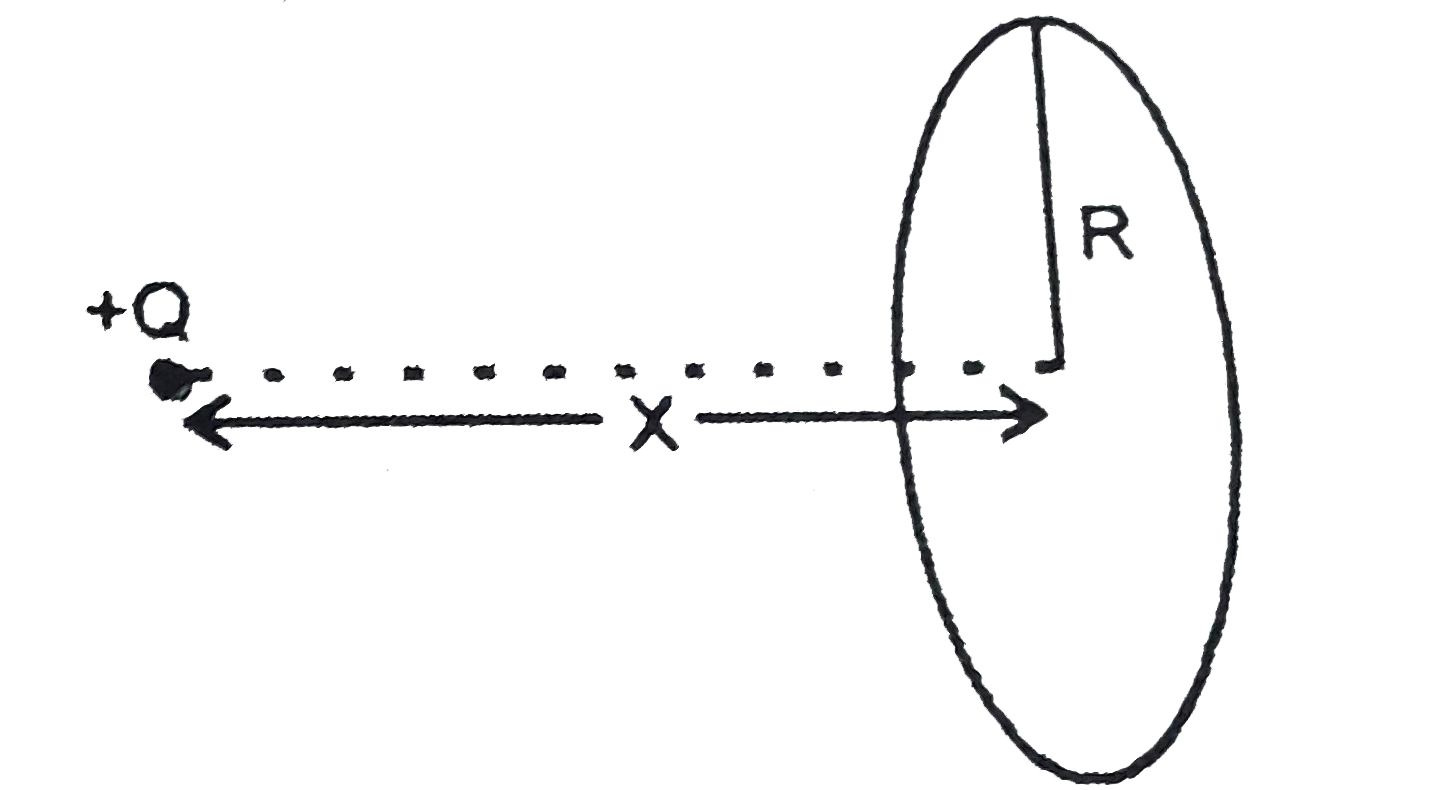There is a uniformly charged ring having radius R. An infinite line charge (charge per unit length lambda) is placed along a diameter of the ring (in gravity free space). Total charge on the ring Q=4√2λR. An electron of mass m is released from rest on the axis of the ring at a distance x=√3R from the centre.

Potential difference between points A(x=√3R) and B(x=R)i.e.(VA−VB) is
−λπɛ0[(1−1√2)−ln34]
−λπɛ0[(1−1√2)−ln34]
−λπɛ0[(1+1√2)−ln34]
none
The correct Answer is:A
Electricfield E=−λ2πɛ0x+Q4πɛ0x(R2+x2)3/2 (considering right direction as positive)
=λ2πɛ0[−1x+x4√2R2(R2+x2)3/2]
=λ2πɛ0[−1x+2√2×R(R2+x2)3/2]
Initiallyx=√3R
E=λ2πɛ0R[−1√3+2√2√38]
λ2πɛ0R⎡⎢
⎢⎣−2√2+3√3(2√2)⎤⎥
⎥⎦=λ2πɛ0R(3−2√22√6)
a(acceleration)=(−e)(E)m=−eλπɛ0mR(3−2√24√6)
Sol(2) Force on electron is zero at point where E=0⇒x=R
Sol(3) Potential difference between two points
ΔV=−Edx
P.d. due to line charge between
x=R&x=√3R
VA−VB=−√(3)R∫R−λdx2πɛ0x=λπɛ0(ln34)
Potential difference due to ring between x=√3Randx=R
VA−VB=14πɛ0(4√2λR2R−4√2λR√2R)=−λπɛ0(1−1√2)
Net VA−VB=−λπɛ0[(1−1√2)−ln34]
Topper's Solved these Questions
- MASTER PRACTICE PROBLEMBook:BANSALChapter:MASTER PRACTICE PROBLEMExercise:Reasoning
Explore 75 Videos
- MASTER PRACTICE PROBLEMBook:BANSALChapter:MASTER PRACTICE PROBLEMExercise:Multiple objective
Explore 131 Videos
- MASTER PRACTICE PROBLEMBook:BANSALChapter:MASTER PRACTICE PROBLEMExercise:Additional topic
Explore 70 Videos
- FLUID MECHANICSBook:BANSALChapter:FLUID MECHANICSExercise:PYQS AIEEE
Explore 10 Videos
- SEMICONDUCTORSBook:BANSALChapter:SEMICONDUCTORSExercise:CBSE Question
Explore 32 Videos
Similar Questions
Electric charge Q is uniformly distributed around a thin ring of radius a. find the potential a point P on the axis of the ring at a distance x from the centre of the ring .

View SolutionPotential on the axis of ring of radius 3R and at distance 4R from centre of ring is (charge on the ring is Q )
View Solution
Knowledge Check
There is a uniformly charged ring having radius R. An infinite line charge (charge per unit length lambda) is placed along a diameter of the ring (in gravity free space). Total charge on the ring Q=4√2λR. An electron of mass m is released from rest on the axis of the ring at a distance x=√3R from the centre.

Magnitude of initial acceleration of the electron.Aeλπɛ0mR(3−2√24√6)Beλπɛ0mR(3+2√24√6)Ceλπɛ0mR(3+2√24√3)DnoneThere is a uniformly charged ring having radius R. An infinite line charge (charge per unit length lambda) is placed along a diameter of the ring (in gravity free space). Total charge on the ring Q=4√2λR. An electron of mass m is released from rest on the axis of the ring at a distance x=√3R from the centre.

The distance from centre of ring on the axis where the net force on the electron is zero.A2RB√2RCRDnone of theseA ring of radius a contains a charge q distributed uniformly over its length. Find the electric field at a point on the axis of the ring at a distance x from the centre.
Akq2x(a2+x2)32B2kq2x(a2+x2)32Ckq2x(a2+x2)32Dkq22x(a2+x2)32
A charge Q is uniformly on a ring of radius R. Find the electric potential on the axis of ring at distance x from the centre of the ring. Sketch variation of potential with respect to x.
View SolutionA quarter ring of radius R is having uniform charge density λ. Find the electric field and potential at the centre of the ring.
View SolutionA ring of radius R is with a uniformly distributed charge Q on it .A charge q is now placed in the centre of the ring .Find the increment in tension in the ring.
View SolutionFind the electric flux due to a point charge 'Q' through the circular region of radius R if the charge is placed on the axis of ring at a distance x.

View SolutionA non-conducting ring of radius r has charge per unit length λ. A magnetic field perpendicular to plane of the ring changes at rate Db/dt. Torque experienced by the ring is

View Solution

